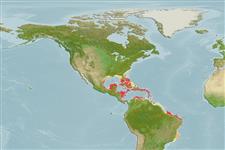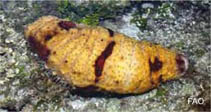Actinopyga agassizi Selenka, 1867
Five-toothed sea cucumber| Native range | All suitable habitat | Point map | Year 2050 |

|
| This map was computer-generated and has not yet been reviewed. |
| Actinopyga agassizi AquaMaps Data sources: GBIF OBIS |
Classification / Names Common names | Synonyms | CoL | ITIS | WoRMS
Holothuroidea | Holothuriida | Holothuriidae
Environment: milieu / climate zone / depth range / distribution range Ecology
Benthic; depth range 0 - 54 m (Ref. 83942). Tropical
Distribution Countries | FAO areas | Ecosystems | Occurrences | Introductions
Western Atlantic: Gulf of Mexico and the Caribbean.
Length at first maturity / Size / Weight / Age
Maturity: Lm ? range ? - ? cm Max length : 35.0 cm TL male/unsexed; (Ref. 624)
A coastal and nocturnal species. Forages on algal turf, seagrass meadows, and in rubble or sand covered areas (Ref. 485). This is an epibenthic, subtidal species found in coral reefs, seagrass and rocky bottoms (Ref. 83942). Nocturnal. Forages on algal turf, seagrass meadows, and in rubble or sand covered areas (Ref. 485).
Life cycle and mating behavior Maturity | Reproduction | Spawning | Eggs | Fecundity | Larvae
Members of the class Holothuroidea are gonochoric and have only one gonad. Spawning and fertilization are both external and some exhibit brooding. Life cycle: Embryos develop into planktotrophic larvae (auricularia) then into doliolaria (barrel-shaped stage) which later metamorphose into juvenile sea cucumbers.
Main reference
References | Coordinator | Collaborators
Hasbún, C.R. and A.J. Lawrence. 2002. (Ref. 624)
IUCN Red List Status (Ref. 130435)
Least Concern (LC) ; Date assessed: 18 May 2010
CITES status (Ref. 108899)
Not Evaluated
CMS (Ref. 116361)
Not Evaluated
Threat to humans
Human uses
| FishSource |
Tools
More information
Internet sources
BHL | BOLD Systems | CISTI | DiscoverLife | FAO(Publication : search) | Fishipedia | GenBank (genome, nucleotide) | GloBI | Gomexsi | Google Books | Google Scholar | Google | PubMed | Tree of Life | Wikipedia (Go, Search) | Zoological Record
Estimates based on models
Preferred temperature
(Ref. 115969): 24.9 - 28, mean 27 (based on 206 cells).
Price category
(Ref. 80766):
Unknown.



